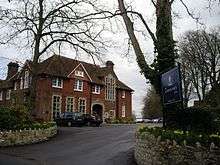Godolphin School
 | |
| Motto |
Franc ha leal eto ge Frank and loyal thou art |
|---|---|
| Established | 1726 |
| Type | Independent day and boarding |
| Headmistress | Emma Hattersley |
| Founders | Charles and Elizabeth Godolphin |
| Location |
Milford Hill Salisbury Wiltshire SP1 2RA England Coordinates: 51°04′08″N 1°47′07″W / 51.0688°N 1.7853°W |
| DfE URN | 126519 Tables |
| Students | c. 450 |
| Gender | Girls |
| Ages | 3–18 |
| Publication | Gazette |
| Website | Godolphin School |
The Godolphin School is an independent boarding school for girls at Salisbury in Wiltshire, England, founded in 1726. The school educates some 430 girls between the ages of eleven and eighteen.
History
Godolphin was founded in 1726 by the Hon. Charles Godolphin and his wife, Elizabeth, for the education of eight young orphaned gentlewomen. According to the terms of the Will, the beneficiaries were to be daughters of members of the Church of England, between eight and twelve years of age, born in Salisbury or some other Wiltshire town, and to have had "some portion left to them but not exceeding £400". The girls were to be taught to "dance, work, read, write, cast accounts and the business of housewifery". This was a fairly advanced curriculum for its time, since girls of this class were expected to be able to read but not necessarily to be able to write. The new charity was initially to be administered by William Godolphin, a nephew of the founders, the Dean and Chapter having declined to take on the task on the grounds that the idea of educating women was "mere foolery and dreaming". Every year, on the second Saturday in November, the School honours its founder Elizabeth Godolphin when the Head Girl, accompanied by members of the Upper Sixth, lays a wreath on her tomb in the cloister of Westminster Abbey. This ceremony is known to girls past and present as "Commem."
The School did not actually open its doors until 1784, when it was set up in Rosemary Lane, in the Cathedral Close, Salisbury. It later occupied various houses in the vicinity, including Arundels, more recently the home of Sir Edward Heath, and finally the King's House. A prospectus of 1789, written by the Headmistress, Mrs Voysey, promised a regime of early rising, "agreeable exercise" and a diet of wholesome books "such as enlarge the heart to Virtue and excellency of Sentiment".
Following an outbreak of cholera in 1848, the School moved to Milford Hill, where for nearly half a century it occupied various premises, including Fawcett House on Elm Grove, which was later to become the Swan School. Under the leadership of Miss Polhill (1854–1857) and Miss Andrews (1875–1890), numbers were small and the curriculum narrow. Then, in 1890, Miss Mary Douglas arrived. Described variously as a 'headmistress of genius' and 'the second founder of the School', her headship saw a tenfold increase in numbers from 23 in 1890 to 230 in 1920, the year she retired. In 1891, the distinctive red-brick building on the top of Milford Hill was opened at a cost of £4000, and in the years that followed several new boarding houses were added. During the 1890s school fees were 4 guineas per term for pupils under 12, 5 guineas for pupils from 12 to 15, and 6 guineas for pupils over 15.
In 1904 an additional six acres were purchased in order to extend the school grounds, which were then landscaped on the side facing Laverstock. In 1914 oak panelling, which gives the Hall its unique atmosphere, was installed; and in 1925 an open-air swimming pool was opened. Additions to the School since the Second World War have included a new library building, several new boarding houses, a science and technology block, a prep school, a performing arts centre, an indoor swimming pool, with fitness centre, a new boarding house (Douglas) and a Sixth Form Centre.
The arms and motto of the School are those of the Godolphin family. The motto Franc ha leal eto ge – is Old Cornish and means 'Frank and loyal thou art'.
The formal uniform is usual for a girls school as it includes a blazer, skirt, shirt, traditional "pinny" and boater.
Headmistresses
- Mrs Voysey
- 1784–: Miss Giffard (Mrs Davis)
- 1815–: Miss Anna Maria Alford
- 1829–: Miss Emily
- 1832–1854: Miss Margaret Bazeley
- 1854–1857: Miss Polhill (Mrs Cother)
- 1857–1875: Miss Emma Polhill
- 1875–1890: Miss M. T. Andrews
- 1890–1919: Mary Alice Douglas
- 1920–1935: Miss Cecily Ray Ash
- 1935–1940: Miss D. M. M. Edwards-Rees
- 1940–1958: Miss G. May Jerred
- 1958–1967: Miss Engledow
- 1968–1980: Miss Veronica Fraser
- 1980–1989: Mrs Elizabeth Prescott-Decie (Hannay)
- 1989–1996: Mrs Hilary Fender
- 1996–2010: Miss Jill Horsburgh
- 2010–2013: Mrs Samantha Price
- 2014– : Mrs Emma Hattersley
Notable former pupils
- Antonia Bernath, actress
- Mary Cartwright, mathematician[1]
- Jilly Cooper, writer
- Molly Harrower, psychologist
- Deborah Meaden, business entrepreneur from BBC's Dragons Den
- Dame Anna Pauffley, High Court judge
- Dorothy L. Sayers, writer[2]
- Theodora Turner, nurse
- Minette Walters, writer
See also
- Godolphin and Latymer School
- The Godolphin Book, compiled by Mary Alice Douglas, published 1928
External links
- The Godolphin School
- Profile on MyDaughter
- ISI Inspection Reports
References
- ↑ Atiyah, Lily (Nov 1998). "Obituary: Dame Mary Cartwright 1900-1997". The Mathematical Gazette. The Mathematical Association. 82 (495): 494–496.
- ↑ Bramlett, Perry C.; Ronald W. Higdon (1998). Touring C.S. Lewis' Ireland & England. Smyth & Helwys Publishing, Inc. p. 80. ISBN 1-57312-191-6.